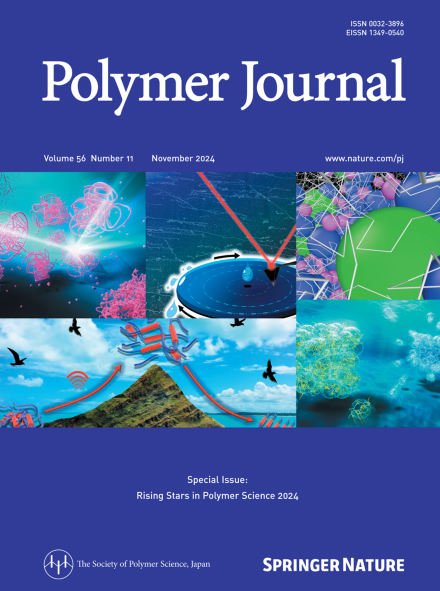Relationship between the heterogeneity in particle dynamics and network topology in transient networks via a microrheological study
IF 2.3
4区 化学
Q3 POLYMER SCIENCE
引用次数: 0
Abstract
Soft materials encompass various hierarchical structures that determine their mechanical properties. However, the relationships between these hierarchical structures and mechanical properties remain unclear owing to a lack of studies on local information and the difficulty in controlling hierarchical structures. Herein, we demonstrate a multiple particle tracking method, which is a representative microrheological measurement method, within transient networks with a precisely controlled network topology. This is the most basic parameter of hierarchical structures. Our results reveal that the heterogeneity in particle dynamics is enhanced and reaches a maximum at the percolation threshold, which is a universal phenomenon in sol–gel transitions. Notably, this study is the first to report that the heterogeneity in particle dynamics within transient networks established via reversible bonds exhibits characteristics similar to those of percolation phenomena in hydrogels. These insights provide a basis for examining the relationships between the mechanical properties and hierarchical structures of soft materials. A multiple particle tracking method was used to track probe particles in Tetra-PEG slimes with various network connectivities, revealing that the deviation from the Gaussian distribution of the particle dynamics is greater than the percolation threshold (network connectivity = 0.34). This study is the first to report that the heterogeneity of particle dynamics in transient networks, formed through reversible bonds, exhibits characteristics similar to those observed during sol–gel transitions.

通过微流变学研究暂态网络中颗粒动力学的非均质性与网络拓扑的关系
软材料包含各种决定其机械性能的层次结构。然而,由于缺乏对局部信息的研究以及难以控制层次结构,这些层次结构与力学性能之间的关系仍不清楚。在此,我们展示了一种多粒子跟踪方法,这是一种在瞬态网络中精确控制网络拓扑结构的代表性微流变测量方法。这是分层结构最基本的参数。我们的研究结果表明,粒子动态的异质性得到了增强,并在渗滤阈值处达到了最大值,这是溶胶-凝胶转变过程中的普遍现象。值得注意的是,本研究首次报道了在通过可逆键建立的瞬态网络中,粒子动态的异质性表现出与水凝胶中渗流现象相似的特征。这些见解为研究软材料的机械性能与分层结构之间的关系提供了基础。研究人员采用多粒子跟踪法跟踪了具有不同网络连通性的四聚乙二醇淤泥中的探针粒子,发现粒子动态的高斯分布偏差大于渗流阈值(网络连通性 = 0.34)。这项研究首次报告了通过可逆键形成的瞬态网络中颗粒动态的异质性,其特征与溶胶-凝胶转变过程中观察到的特征相似。
本文章由计算机程序翻译,如有差异,请以英文原文为准。
求助全文
约1分钟内获得全文
求助全文
来源期刊

Polymer Journal
化学-高分子科学
CiteScore
5.60
自引率
7.10%
发文量
131
审稿时长
2.5 months
期刊介绍:
Polymer Journal promotes research from all aspects of polymer science from anywhere in the world and aims to provide an integrated platform for scientific communication that assists the advancement of polymer science and related fields. The journal publishes Original Articles, Notes, Short Communications and Reviews.
Subject areas and topics of particular interest within the journal''s scope include, but are not limited to, those listed below:
Polymer synthesis and reactions
Polymer structures
Physical properties of polymers
Polymer surface and interfaces
Functional polymers
Supramolecular polymers
Self-assembled materials
Biopolymers and bio-related polymer materials
Polymer engineering.
 求助内容:
求助内容: 应助结果提醒方式:
应助结果提醒方式:


